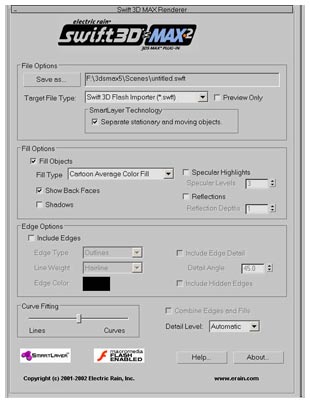Swift 3D: Vector Animation for the Web
Swift 3D: Vector Animation for the Web
By Nathan Segal. July 9, 2003.Over the past few years, Electric Rain has been building plug-ins that allow 3D users to render files into a variety of vector file formats, including Flash SWF. Swift 3D creates scalable vector artwork for the web. Currently, the Swift 3D plug-in is available for 3D Studio Max and Lightwave and is also available as a standalone application.
There are many companies that allow the user to create 3D models and animation. Typically, the end product is a raster animation, a frame by frame rendering process. To export this animation, you would need to use an MPEG or AVI raster based format. Raster images vary in size and the amount of processing to create those frames can be considerable. The end product can create amazing results with film and video, but on the web, you’ll run into all sorts of bandwidth limitations.
If your output is a small AVI movie, that could suit your purpose, but for larger animations and effects, raster imagery is not the best approach. This where Flash and Shockwave come into play. While both are plug-ins run in your web browser, it’s important to understand the differences.
The Shockwave player has a built-in 3D rendering engine. When you build an object in 3D Studio Max or Lightwave, you can export that 3D geometry to the Shockwave format. From there, the Shockwave player interprets the data and allows you to interact with it.
Flash, on the other hand, was originally designed as a vector animation player. When you look at a cartoon in Flash, it’s composed of lines and fills, not raster imagery. These days, Macromedia has upgraded the capabilities of Flash to incorporate bitmaps, along with video and sound. But there is no 3D rendering component in the Flash player, so you can’t sent 3D geometry to it.
To maximize the use of Flash, one approach is to convert the 3D geometry to vector imagery up front, which is where the Swift 3D plug-in comes in. Another approach is to create your entire animation within the standalone application of Swift 3D.
As an example, if you built a 3D model of a film reel in 3D Studio Max, you can move it in 3D space, and create an animation of that. Once you have the animation, you would then export that to Flash, which turns the 3D image into a 2D image over a given number of frames. The animation will be redrawn as a vector animation of lines and fills. The completed animation will play sequentially in Flash, simulating 3D movement. And with vector imagery you have the advantages of file sizes and scalability, unlike an AVI file.
With raster imagery, you can generate images of excellent quality, but those textures and patterns are difficult to replicate with vector imagery.
 As
a plug-in, the primary purpose is for rendering and export and in 3D Studio
Max, Swift 3D acts as a rendering component of the 3DS Max application and all
of its functionality resides within the rendering rollout. Depending on which
version of Max you’re using (4.x or 5.x), you’ll need to activate
the plug-in by going to Render> Render on the main menu bar and under the
Current Renderers rollout, assign the Swift 3D Max Renderer as your production
and/or draft renderer.
As
a plug-in, the primary purpose is for rendering and export and in 3D Studio
Max, Swift 3D acts as a rendering component of the 3DS Max application and all
of its functionality resides within the rendering rollout. Depending on which
version of Max you’re using (4.x or 5.x), you’ll need to activate
the plug-in by going to Render> Render on the main menu bar and under the
Current Renderers rollout, assign the Swift 3D Max Renderer as your production
and/or draft renderer.
For output, you can choose from several different formats: Swift 3D Flash Importer (SWFT), which can be read by the Swift 3D Importer for Flash MX, Macromedia Flash (SWF), Adobe Illustrator (AI), Encapsulated PostScript (EPS), Scalable Vector Graphics (SVG) and USAnimation (PNT).
When rendering your 3D scenes into vector files, what-you-see-is-what-you-get
doesn’t necessarily apply here, since there are several different vector
rendering choices with the RAViX III rendering engine.
Created: June 5, 2003
Revised: June 5, 2003
URL: https://webreference.com/3d/column2


 Find a programming school near you
Find a programming school near you